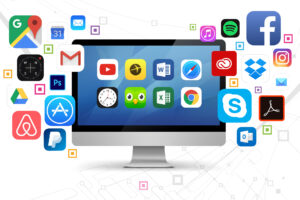Tools for distance & online learning
Digital technologies emerge as a potent tool with the capacity to enrich education on multiple fronts. They streamline the creation of instructional materials for teachers and offer innovative modes of studying and communication for individuals. The global reach of the Internet and the extensive utilization of connected intelligent devices mark the beginning of a new era. Consequently, the responsibility rests with instructional designers and educators to leverage the capabilities of advanced digital technology, initiating a transformative period in education aimed at providing accessible, high-quality learning opportunities for all, irrespective of their location.

In the constantly changing realm of education, the significance of technology has been a matter of discussion for centuries. The process of integrating technology into education has unfolded over an extensive period of 2,500 years, with ongoing debates about its impact persisting throughout history. To attain a thorough comprehension of this progression, it is imperative to explore its historical roots. Paul Saettler’s ‘The Evolution of American Educational Technology’ (1990) emerges as a valuable reference in this regard. While this historical narrative covers developments only up to 1989, it provides a fundamental basis for acknowledging the substantial transformations that have transpired in the subsequent years.
Transitioning to virtual learning settings brings forth challenges, especially concerning providing fair access to all students. The article “Optimal Tools for Virtual and Distance Learning” from Common Sense Education highlights the importance of tackling issues such as home access and educator preparedness. It stresses that possessing high-quality tools is not enough on its own; guaranteeing accessibility and thorough preparation is essential to emulate the richness of in-person learning experiences. Whether adapting an existing curriculum or embarking on a new approach, this resource assists educators in creating effective virtual learning environments.
Empowering Instructors: 7 Top Tech Tools for Effortless Teaching
In the ever-changing landscape of educational technology, keeping up with user-friendly tools is essential for educators. The YouTube video “7 Best Easy to Learn Tech Tools for Teachers” is a valuable reference, showcasing seven tools crafted to enhance different facets of teaching:
- Class Dojo: A tool designed for behavior management.
- One by Wacom: Facilitates drawing and creative expression.
- Canva: Ideal for graphic design and visual communication.
- Baamboozle: Engages students through educational games.
- ClassPoint: Enhances presentations through interactivity.
- Kumospace: Enables virtual meetings and collaboration.
- Edpuzzle: A platform for creating online video lessons with embedded questions.

These tools cater to a variety of teaching needs, promoting simplicity, customization, and accessibility. From managing behavior to fostering creative expression, facilitating interactive learning, and enabling remote instruction, they enhance communication among teachers, students, and parents. As educators immerse themselves in the technological landscape of education, these tools not only streamline the teaching process but also contribute to a more engaging and interconnected learning experience. The amalgamation of historical context and contemporary tools equips educators to navigate the challenges and opportunities presented by the ever-evolving world of distance and online learning.
Students can prepare for a lifelong learning journey with the assistance of digital tools within the classroom. These tools grant students entry into a virtual realm, allowing them the flexibility to engage with digital content in alignment with their preferred learning methods. The availability of custom teaching and learning approaches through digital content development tools empowers students to learn at their own pace. The digital classroom seamlessly incorporates technology into education, utilizing electronic tools and software for instructional purposes. With2aaaaW the aid of contemporary tools and technology, students can accelerate their learning and track their progress. These technologies are anticipated to be seamlessly integrated into education in the coming years, enhancing the online learning environment and boosting student performance. However, it is imperative for educators to possess fundamental knowledge of utilizing internet forums. The government should invest in teacher training programs to equip them with the skills needed to adeptly incorporate digital tools into the classroom.
Hey dida, Your blog talks about how digital tools are changing education for the better. It mentions a book that explains how technology in education has evolved over a long time. The blog also discusses how important it is for teachers to be ready for online learning and talks about some tools that can help make teaching easier.It mentions a video that shows seven easy-to-use tools for teachers. These tools help with things like managing behavior, drawing, making graphics, playing educational games, making presentations more interesting, having virtual meetings, and creating online lessons with questions.The blog also talks about how students can use these tools to learn at their own pace and how technology is becoming a big part of education. It suggests that teachers should learn how to use the internet and that the government should help teachers learn about these tools.Overall, it’s a helpful guide for teachers to understand how technology is changing education and how they can use these tools to make teaching and learning more fun and effective.
🙂 Thanks for your valuable feed Navneet